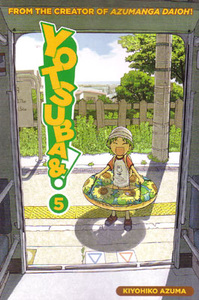Review
by Carl Kimlinger,Yotsuba&!
GN 5
| Synopsis: |  |
||
Summer is drawing to an end and Yotsuba is determined to grab life by the throat and throttle it. Not that that has anything to do specifically with summer, that's just how our tiny green-haired heroine lives her life. And it's not like she has anything unusual in mind: running errands, "helping" her long-suffering neighbors, stargazing, beachcombing, eating ice-cream, befriending Cardbo the cardboard robot...things like that. For someone as curious and unworldly as Yotsuba, even the most mundane experience is an adventure. Meeting her father's co-worker is an epic battle of wills, a trip to the video rental a lesson in puddle-splashing connoisseurship. When they're not being every bit as odd as she, Yotsuba's slowly widening circle of friends and acquaintances does an admirable job of enjoying her boundless enthusiasm, even while they occasionally take advantage of her guilelessness. |
|||
| Review: | |||
After mining the nostalgia of high school in Azumanga Daioh, perhaps it was natural that Kiyohiko Azuma would take a step back and mine childhood next. In Yotsuba&!, he levels the same sympathetic gaze and odd yet insightful humor that made Azumanga a hit at childhood innocence. It's arguably even gentler and more sharply observed than its celebrated elder sibling, and unarguably better drawn. Capturing the wonder of childhood, where everything is fresh and new and a day can stretch on for an eternity, isn't a simple matter. American comic strips are littered with the bile-raising wreckage of countless attempts (The Family Circus comes to mind). Cynicism thinly disguised by schmaltz, syrupy cutesiness, irrational idealization, and reduction to stereotypes are but a few of the traps that any such attempt can fall into. Few can avoid them all. Bill Watterson did it with Calvin and Hobbes; Azuma does it here. And like Watterson, Azuma makes his magic by placing readers in a child's shoes, not as observers of childhood, but once again as participants in it. You couldn't ask for better shoes to be in. Yotsuba's enthusiasm for life is infectious, her moods capricious, and her outlook hilarious. If you must have a comparison (and you've read or seen Azumanga) imagine Chiyo's body and Tomo's energy as ruled by Osaka's personality. Her reasons for thinking that Yanda, her father's co-worker, is a bad person are totally petty and totally understandable. Her persistence, against all reason, in attributing ill to him (upon blinding herself with a flashlight and ending up head-first in a trash can, she cries out "curse you Yanda!") is as honestly childlike as it is funny. Further fun is supplied by a supporting cast in which maturity seems to have an inverse relation with age—youngsters like Miura and Ena are even-keeled, while supposed adults like Fuka and Jumbo are just oversized children. What is really special about Yotsuba, though, is that newness with which she, as a child, sees the world. That the manga allows us to glimpse the world through those same eager eyes is what gives it appeal far beyond its humor. And it's in this that Azuma's decision to move past the four-panel format really pays dividends. He still prefers fairly straightforward rectangular layouts, but the variety of angles, panel sizes, and compositions permitted by a continuous format allows him to create a vastly wider range of moods than before. With it he can stretch out simple tasks, like washing a bathtub, until they become the miniature adventures, and can build to little scenes of everyday lyricism, such as Yotsuba sleeping in the late afternoon sun, a late-night outdoor meal, or the simple beauty of a flashlight beam shining into the night sky. His drawing is also much improved. Though the roundness of face and eyes is enough to let you know that this is indeed the same person who drew Azumanga Daioh, characters are far more realistic and detailed—some good (enjoyable, but not extreme enough to make you feel bad for enjoying it) Fuka fan-service at the beach demonstrates an understanding of human anatomy only hinted at in Azumanga. Backgrounds are carefully drawn, frequently utilized and often beautiful. Indeed, the only drawback to his art is a slightly bothersome predilection for outrageous expressions and reactions. ADV's book is on par, quality-wise, with its more prolific competitors like Del Rey. It feels solid enough to warrant ten bucks. The printing blurs none of the wealth of detail in the backgrounds and character's clothing, keeping all of the shades of grey and black crisp and distinct. Typos are more or less non-existent, and the dialogue reads smooth with Yotsuba's in particular having a nice, distinctly childlike feel (though nearly every sentence ends in an exclamation point). Sound effects are left in situ with a small, appropriately fonted, English translation incorporated into the art nearby. Translation notes are unobtrusively inserted into the spaces between panels where necessary. Despite revolving around a young girl, Yotsuba&! is not aimed at children. It isn't inappropriate (that "All Ages" rating is well-earned), or even necessarily pitched over children's heads (though it is slowly paced and literate). It's simply that the people most likely to enjoy it are adults, those who need a little reminder, the one that the manga itself puts best when it ends with the simple words "enjoy everything." Maybe that isn't possible any more, but you can certainly enjoy this. |
| Grade: | |||
|
Overall : A-
Story : A-
Art : A-
+ Funny and observant yet as innocent as its lead. |
|||
| discuss this in the forum (6 posts) | | |||
| Production Info: | ||
|
Full encyclopedia details about Release information about |
||